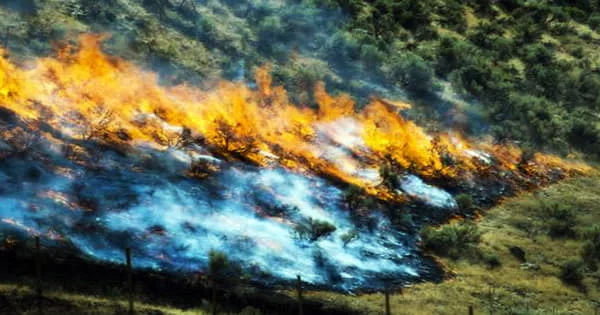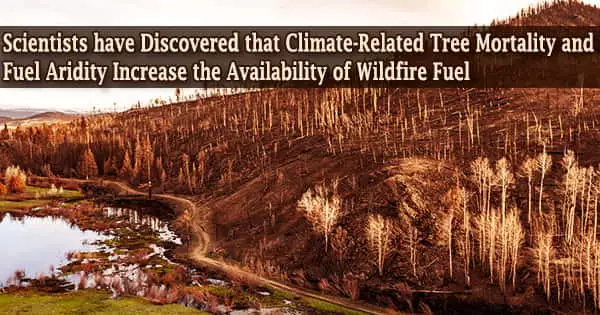Climate-driven tree mortality and fuel aridity, according to new research from the University of New Mexico, are boosting fuel availability in forests, resulting in record-breaking wildfire size, spread, and plume formation.
Climate change is increasing the amount of energy stored in biomass that can be released as heat during wildfire in North America, which is increasing the amount of energy stored in biomass that can be released as heat during wildfire. Drought stress, insect outbreaks, and rising temperatures have resulted in widespread tree mortality, while rising temperatures are drying up forest fuels, making them more readily available for combustion.
The quantity of water held in live and dead biomass, which acts as a regulator on the amount and rate of energy release, determines the amount of energy stored in forests that is available for release from fire.
The combined effects of tree mortality and high temperature may be responsible for the substantial energy release that has characterized modern wildfires. Fuel moisture of dead biomass is more responsive and fire-prone with increasing temperature than live biomass, and the combined effects of tree mortality and high temperature may be responsible for the substantial energy release that has characterized modern wildfires.

The research, “Climate-driven tree mortality and fuel aridity increase wildfire’s potential heat flux,” conducted by UNM scientists Marissa Goodwin and Matthew Hurteau, was published recently in Geophysical Research Letters. The study employed temperature and fuel moisture data for both live and dead trees to analyze climate-driven changes in fuel moisture content over the past three decades, which looked at tree mortality as a result of climate change and an increase in fuel aridity.
The researchers also assessed the changes in energy release (energy release component and fire radiative energy) from two forests in the western United States that were affected by drought and bark beetle mortality and then burned by wildfires during the 2020 fire season.
In modern California history, the Creek Fire in the Sierra Nevada was the seventh-largest. The Cameron Peak Fire in the Colorado Rocky Mountains, which was the largest in Colorado history, burned through forests with huge numbers of bark beetle-killed trees, while the 2012-2016 drought and associated bark beetle outbreak resulted in extensive tree loss.
Coupled with climate-driven decreases in fuel moisture content, this change in fuel availability increased the amount of energy that could be released as heat during wildfire in these forests. These results demonstrate that climate-driven tree mortality and fuel aridity may be increasing the amount of energy that is released during wildfire.
Marissa Goodwin
The climates of the two forests differ, with mixed-conifer forests in California’s Mediterranean climate being seasonally dry and Colorado’s lodgepole pine forests being chilly and wet, but fuel moisture and availability influence fire intensity in both places.
“We found that tree mortality transitioned substantial amounts of biomass from live to dead pools,” says Goodwin, a master’s student in the UNM Department of Biology and lead author of the paper.
“Coupled with climate-driven decreases in fuel moisture content, this change in fuel availability increased the amount of energy that could be released as heat during wildfire in these forests. These results demonstrate that climate-driven tree mortality and fuel aridity may be increasing the amount of energy that is released during wildfire.”
Since 2016, Goodwin has served as a project manager for The Teakettle Experiment, which is now administered by Hurteau as part of his Earth Systems Ecology Lab. The Teakettle Experiment began in 1997 with the goal of determining the ecological effects of forest management strategies such as planned fire and mechanical thinning.
The number of trees that have died in those forests is startling, providing plenty of dead fuel for wildfires to ignite. Over the last five years, an estimated 36 million trees in the Sierra National Forest have died due to drought and bark beetle mortality, accounting for around 25% of the forest’s trees. A CALFIRE assessment revealed estimates of 80% tree mortality in the area where the Creek Fire burned.
According to Colorado’s Forest Inventory and Analysis Data, lodgepole pine mortality from Mountain Pine Beetle infestation ranges from 40 to 50 percent, with death affecting 87 percent of the state’s lodgepole pineland, or around 3.4 million acres.
“The amount of vegetation that’s available to burn is controlled by how much water that vegetation stores,” said Hurteau, a professor in the UNM Department of Biology and also a co-author on the paper. “As we move trees from the live column to the dead column because of insects and drought, they’re not taking up water the way a live plant does. They hold a lot less water and become more available to burn. It is similar to building a campfire, dry wood makes a better fire than wet wood.”
The Creek Fire of 2020 was coming off a dry winter, thus there wasn’t much precipitation that year. Then, throughout that spring and summer, the temperatures were extremely high, causing all of the deadwood from the 2012 to 2016 drought to dry out and become suitable for burning. There is a proven positive link in which as the temperature rises, more surface area burns.
Scientists from the USDA Forest Service’s Pacific Northwest Research Station and USDA Forest Service’s Pacific Southwest Research Station, respectively, were interested not just in the ecosystem burning, but also in how it burns.
“We’re trying to understand the relationship between the climate piece and how all this tree mortality from drought and insects is going to change the amount of fuel available,” said Hurteau.
“When you have all that additional fuel from all the dead trees, it’s going to burn a lot hotter. In the Creek Fire, the plume was 50,000 feet in the air so that was a lot of energy moving out of the system. When you release that much energy, the fire creates its own weather, and you get really extreme behavior.”
“What I found most telling (from the research) is that high temperatures in 2020 resulted in lower fuel moisture contents and higher calculated energy release than we saw during the drought periods these two forests experienced,” said Goodwin.
“Drought and beetle mortality transitioned a substantial amount of biomass on these landscapes from the live fuel to dead fuel types. When you have all this dead fuel and then also turn up the thermostat, everything was just primed to burn when those two fires occurred.”
Support for this project came from the California Department of Forestry and Fire Protection (CAL FIRE) as part of the California Climate Investments Program.
















